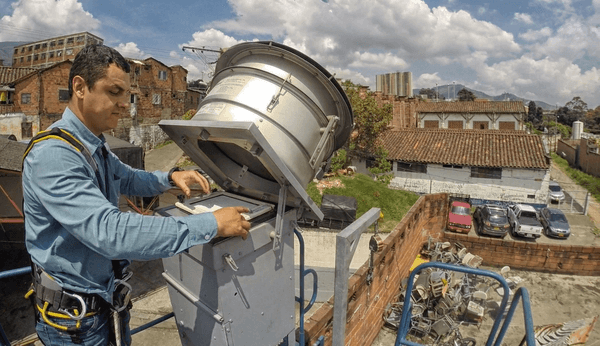An inter-federation model make feasible for the municipalities to manage their waste in an integrated way.
Since 2010, the competence for the management of solid waste in Brazil lies in the municipalities. In June 2012, a cooperation agreement was signed among 43 of the then existing 50 municipalities in the Metropolitan Region and in the Metropolitan Belt of Belo Horizonte for the shared management of the transshipment, treatment, and final disposal of the urban solid waste.
The State Government, in turn, received from the municipalities, through a schedule contract, part of the competence; that is, it was up to the State Government to contract a Public-Private Partnership (PPP) for the exploration of the services of transshipment, treatment, and final disposal of the urban solid waste. In the schedule contract, the municipality commits to pay around 20% of the contribution of funds for the operation of the PPP and the 80% remaining to the State.
The shared management among the government, the municipalities, and the private sector will allow for the reduction of the cost of the entire process, and for the increase in efficiency of several services such as the elevation of the indices for reuse and recycling, energy production - which may be done through methane gas, fuel derived from the waste, and the socio-productive inclusion of trash pickers through their organizations.
This Case Study is part of the Comparative Study on Metropolitan Governance (São Paulo Metropolis Initiative).
Integrated Metropolitan Governance in Rosario is also part of the Comparative Study on Metropolitan Governance.
Guangzhou Award
This project was shortlisted for the 'Guangzhou Award' in 2012 in the following category: Deserving Initiative.
The improper disposal of solid waste has been generating a serious environmental problem for many cities, resulting in pollution of the water courses, air and stimulating the generation of degraded areas.
It turns out that most of the Brazilian municipalities have difficulties and limitations which prevent them from facing this issue alone. Most of them are small municipalities, with limited budgets and without enough waste volume to guarantee the economic feasibility for enterprises.
In 2010, the Brazilian federal government approved the law that established the National Policy for Solid Waste (PNRS - Política Nacional de Resíduos Sólidos), an instrument destined to guide the strategic actions in the environmental area, outlining guidelines, strategies, and goals for the future. The policy aims at a more proper disposal of solid waste from the various producing sources, and not only the domestic waste. It also foresees the end of the improper management of the trash, thus excluding the step of disposal in the famous “dump yards”. The municipalities which do not have proper systems shall implement adequate landfills, or go beyond that, adopting more advanced waste management systems. In order to be more feasible, these alternatives will demand minimum levels (adequate quantities of trash to make up for the investment) and the convenient proximity to the municipalities, since the waste transportation is one of the more expensive components of the solid waste disposal or treatment process.
Such circumstances create a favorable environment for close cities, occasionally in a conurbation, to study cooperation ways to adequately deal with the garbage they produce. This was the process conducted by the Metropolitan Region of Belo Horizonte and its Metropolitan Belt, with the support from the State Government. The government had already been promoting studies aiming at a proposal for grouping the municipalities, so the urban solid waste could be managed jointly. The studies originated the Optimized Territorial Arrangements (ATOs - Arranjos Territoriais Ótimos), a proposal that sought to make technically and economically feasible for the municipalities to manage their waste in an integrated way.
In 2010, Minas Gerais State released an Expression of Interest Procedure (PMI - Procedimento de Manifestação de Interesse) inviting the municipalities, public civil associations, and the private sector to contribute in the structuring of the State Plan of Public-Private Partnerships and in the implementation and operation of the services regarding the urban solid waste treatment. The Expression of Interest Procedure has taken into consideration the format of 51 groups with at least one hub city and, preferably, with a population of at least 100,000 inhabitants. The Optimized Territorial Arrangements (ATOs) proposed the organization of a certain number of grouping of municipalities in which the distance among them were of approximately 30 km.
After the consolidation of the reports received during the Expression of Interest Procedure, Minas Gerais State found necessary to choose a region of the execution of a pilot project, approving then the Public- Private Partnership project for the exploration of the services of transshipment, treatment, and final disposal of the urban solid waste in the Metropolitan Region of Belo Horizonte and in the Metropolitan Belt. The competence for the management of solid waste lies in the municipalities, and, to start the process, in June 2012, a cooperation agreement was signed among 43 of the then existing 50 municipalities in the Metropolitan Region and in the Metropolitan Belt for the shared management of the transshipment, treatment, and final disposal of the urban solid waste.
The State Government, in turn, received from the municipalities, through a schedule contract, part of the competence; that is, it was up to the State Government to contract a Public-Private Partnership (PPP) for the exploration of the services of transshipment, treatment, and final disposal of the urban solid waste.
In the schedule contract, the municipality commits to pay around 20% of the contribution of funds for the operation of the PPP and the 80% remaining to the State. The basis for the calculation formula to pay the private partner is the quantity, in tons, of garbage generated in the municipality that shall be delivered to the transshipment station, or directly to the Urban Solid Waste Treatment Central. The shared management among the government, the municipalities, and the private sector will allow for the reduction of the cost of the entire process, and for the increase in efficiency of several services such as the elevation of the indices for reuse and recycling, energy production - which may be done through methane gas, fuel derived from the waste, and the socio-productive inclusion of trash pickers through their organizations.
The municipalities will keep being responsible for the household waste collection, and shall fulfill some requirements from the state, such as implementing selective collection and supporting organizations of waste pickers. The partner company shall be responsible for the investments in transshipment, treatment, and final disposal of the urban solid waste. The PPP - an administrative concession - was signed in 2014, and three companies united in a consortium were the winners.
The PPP contract is valid for 30 years, and the total amount was USD 1,032 billion The construction of transshipment stations shall happen in 12 months from the signing of the contract, and the construction of the Treatment Center, in up to 48 months, also from the signing of the contract.
The inter-federation cooperation model, in which the municipalities get together in forming and consolidating a consortium solution, in spite of the long process for its structuring, given the institutional complexity, is shown to be highly productive. It is also a contemporary proposal, once it permits the processing and the solution of the problem in an associated way, with bulk gains and sharing of spaces, personnel, funds, and materials. The project shall help approximately 3 million people, which represents 15% of Minas Gerais’ population. That percentage produces around one fifth of all urban solid waste generated in the state, which corresponds to an estimated daily generation of 3 thousand tons, in average, through three decades of the contract. The process, however, was lengthy with advancements and regressions, resulting in some lessons to be learned.
In Brazil and in several places around the world, the political class is not used to sharing structures and power. Because of that, the consolidation of the consortium proposal took a while and required a great negotiation ability.It is necessary to point out that, even after the consent from each mayor to take part in the Cooperation Agreement which formalizes the consortium solution, the execution of the schedule contract which establishes and regulates the mutual obligations among the federation entities involved was not concluded.
There is still a great deal of immaturity in the dialog between the government and the private sector, mainly regarding the evolution of a PPP. The first procurement process for the PPP in November 2013 had no bidders whatsoever. Minas Gerais’ Government revised the partnership terms and release and new procurement process in 2014, successfully this time.
Right from the start, the State Environment Office, the Economic Development Office, and the State Prosecution Office were participants. The latter is also an intervening party. With that, there was a higher efficiency and an assurance of the preservation of the civil society’s interests.
The opportunity must be taken outline the proper governance for the consortium solution, foreseeing the participation of various stakeholders, who must figure, whenever possible, in the governance structures, thus formalizing their support to the projects.
- Comparative Study on Metropolitan Governance, Metropolis, Report 2014, p.55-58.
Want to know more about this project?








